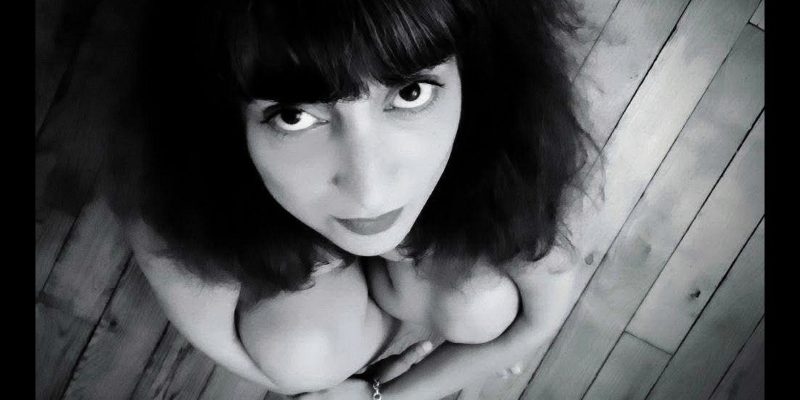To coincide with the launch of one of this year’s most interesting, unusual and compelling original debuts, we sat down with songwriter, artist and performer Shereen Suleiman, to talk about the complexity and power of Ghareeb. Here’s how it went.
* * *
Hi Shereen – great to meet you, I’m so excited to talk about your new release! Ghareeb is brilliant – a perfect encapsulation of its name, and completely artistic from the production to the structure to the vocals and story. It’s like minimalist, industrial, warped trip-hop in a way. What was the process like for building this from the ground up – what came first, and what was your intention?
Thank you very much — your description perfectly matches what I wanted. Ghareeb was born gradually, from a specific moment in my life: I had started writing this track some time ago, in a different period, a stage where I was not the same.
Initially, there was a primary sketch — an embryo, a sound, an emotion — and I didn’t really know what the final outcome would be. It came to me first as an impulse to write, without a fully defined plan.
I don’t always work linearly: I have an idea in mind, sometimes a general structure, a feeling or an image I want to achieve, but I leave a lot of room for experimentation. In other words, I have a direction and landmarks in my head, but the process often reveals itself as I go along. From the outset, I knew one essential thing: Ghareeb had to be the expression of an intimate story — the distortion of an identity in a potentially toxic relationship.
This intention was not just lyrical; I wanted the music, the structure, the textures, and the voices to convey this alteration of identity, this crushed “self.” Voices played a central role from the very first demo. It wasn’t just about singing a melody, but about creating a vocal landscape where each voice embodies a different facet of identity. I layered registers, multiplied takes, sometimes distorted the main voice so that it sounded muffled or fractured; other voices acted as echoes, complicities, or opposing forces.
These vocal layers represent internal dialogues — parts of oneself that respond, confront, or fade away. The vocal texture had to give the impression of a being that is both decomposing and reconstructing: overlapping harmonies, whispers, saturations, voices emerging at the edge of the mix like snippets of memory.
This is why the track may seem “almost distorted”: the voice itself is worked to convey this strangeness and intimate violence. Finally, the demo became the basis of patient work, where the form imposed itself through trials, multiplied voices, and sound layers, each representing an identity facet.
The entire track — lyrics, voices, textures, structure — had to converge to make audible the suffocation and the search for self in a weakened “me.”
It’s difficult for unorthodox music to connect sometimes, but you’ve achieved an impressive balance between outlandish and addictive escapism here – the heartbeat of the rhythm, the ambient warmth, the short melodies and fragments of intriguing sounds. You describe it as ‘powerful yet restrained’ – what does this mean for you, and why did you want to represent that quality?
Ghareeb is my first single, my first official step into music as a singer-songwriter, and it’s a foundational experience. I have always been close to music — I have made it, broadcast it, talked about it — particularly through my show on Radio Grenouille in Marseille, where I offer sets focused on alternative music from the Middle East and North Africa.
I also have a background in cinema and theater, which gave me a taste for storytelling, rhythm, and staging. But until Ghareeb, I had never had the courage to take the plunge: to create my own sonic material and present it as a personal work. This track was a school. I learned by doing it, literally. Each step — writing, production, voice, mixing — was a discovery.
And as I worked, I understood that Ghareeb went beyond the scope of a song. It is a sonic performance: an exploration of voice, breath, sound, and their narrative power.
“I never conceived it as a classically structured track, but as an experience to be lived rather than just listened to.”
The voice here is both instrument and character: it breathes, chokes, whispers, saturates, doubles itself. Every breath, every sigh, every silence has a function. The multiple voices embody identities that overlap or cancel each other out, much like layers of memory.
I wanted the listener to physically feel what runs through the track — this tension, this oppression, this search for air. Even the electronic sounds, the industrial textures, are constructed to dialogue with the voice: they don’t accompany it, they impact it, compress it, reflect it. By working this way, I realized that Ghareeb was closer to a live performance than a fixed composition. It is a work where the body and voice become instruments of narration.
I didn’t want to sing to “sound pretty” or “illustrate a text,” but to convey an emotional state, almost carnal. This approach opened a door for me: I understood that my way of making music involved voice and gesture, instinct rather than technique. Ghareeb is as much a song as it is a sensory experience — a way of telling without telling, of saying without necessarily saying.
The song reaches out to those who’ve felt consumed by love and / or disconnected from their true self. What do you hope those people take away from the music?
I don’t like to talk too much about a “message,” because I’m not trying to deliver a lesson or a moral. What matters most to me is conveying a state, an emotion, a vibration.
Ghareeb tells the story of a woman who has lost herself in a toxic relationship, to the point where she no longer knows who she is. But the piece isn’t tragic—it speaks of liberation. That’s why I wanted to avoid pathos, complaints, or the victim mentality.
“I wanted to portray a conscious, lucid, and strong woman. She’s not someone who merely endures; she’s someone who moves through the experience, understands it, and rises above.”
The piece carries raw emotion and an energy that leaves no one indifferent. But this power is contained—it doesn’t explode demonstratively. It’s held back, compressed, tense. When we played the track for the media, reactions were often decisive: people either loved it or were puzzled. The observation that kept coming back was that it’s original, strange, creative.
I knew it wasn’t a “mainstream” track. It’s in Lebanese Arabic, its structure is unconventional, and the lyrics carry significant weight. If listeners don’t understand the words, they might miss an important access point to the emotion. The power I’m speaking of isn’t one of brilliance but of inner intensity—a deep presence that manifests through textures, voices, and a silence that is sometimes more eloquent than a scream.
The ending of the track is especially important to me because it marks a reversal. It’s not a sad conclusion but a moment of clarity and power. The woman rediscovers her joy, her strength. She understands that the departure of this person—who was suffocating her—isn’t a loss but a deliverance. This departure brings her peace, recenters her, allows her to flourish.
She can finally breathe.
Is this debut set to be typical of your style, or will there be no rules, no confines, as you continue to create?
No, I don’t think Ghareeb alone defines my musical universe. Of course, it’s part of it, it carries its essence, but I don’t want it to be perceived as a single direction. I’m someone who’s free, who likes to explore and not confine myself to a specific style.
Right now, I’m working on a new track that will be released soon called “Fiq” — which means “in you” in Arabic, scheduled for early December. It’s a piece completely different from Ghareeb, more musical in its construction, more open in its soundscapes. This time, I really consider it a musical piece in the full sense, whereas Ghareeb was more of a vocal and sonic performance.
For this project, I’m collaborating with Lebanese pianist Marc Ernest, a wonderful musician. Working with him brings another dimension to my music: more organic, more melodic. The track will be released in early December, and I’m very happy about it.
I’m also preparing an album, which I conceive as a space for circulation between several musical universes. I’m not trying to create artificial coherence; on the contrary, I like moving from one universe to another, deconstructing, exploring, sometimes breaking the codes to better reinvent them. I don’t want barriers, neither in form nor in styles.
My artistic identity will always be there — it’s inevitable, it runs through everything I do. But it doesn’t manifest through repetition or a formula. Rather, it translates into a state of mind, a sensibility. I like to experiment, to be in motion. I don’t set myself any framework or limits, because it’s in this freedom that I feel most alive, most sincere.
Does live performance play a role in your plans?
Live performances are definitely part of my projects. For me, performing live is the natural continuation of the work of composing and recording in the studio. After shaping the songs in the workshop, I see the stage as a living laboratory where music can unfold differently: with more organicity, unpredictability, and intensity. On stage, the songs are not fixed: they breathe differently, expand or contract, gain immediacy, and become a space for direct interaction with the audience.
Live performances also allow for the integration of visual elements, silences, breaks – tools to convey the emotions of the album differently and create a tangible dialogue with those who are listening.
What’s your biggest ambition for this single and your music over the years ahead? Is there anything else we should know?
My primary ambition with Ghareeb was to finally dare to speak up and fully embrace my work in music. For years, I worked in creative fields across various mediums—radio, theater, and cinema—accumulating texts, ideas, and narratives that I had never dared to bring to the forefront of my artistic practice. With Ghareeb, I made the conscious decision to liberate myself from the burden of “what I should have done.” I am taking the leap, with the unwavering commitment not to compromise what I want to express.
I am fully aware that Ghareeb is not necessarily accessible in conventional terms: it is experimental, at times demanding, and deliberately disorienting—and that is precisely what draws me to it. This project represents the beginning of a much larger artistic journey—the entry point into a body of work that will unfold progressively. It encompasses future releases, an upcoming album, diverse collaborations, and varied stage performances that will explore different artistic forms and expressions.
This is not simply about releasing a single track; it is about establishing a creative trajectory that reflects my evolving artistic vision and my determination to no longer defer my musical ambitions. Ghareeb marks the moment I stopped hesitating and started creating on my own terms, embracing complexity and authenticity over commercial accessibility.
* * *
Find Shereen Suleiman on Instagram.

